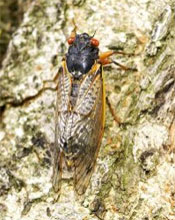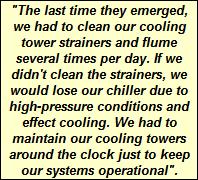 |  |  |
By Randy Simmons
Did you ever wonder what insects make that very loud buzzing sound in trees during the daytime in summer? Well, it’s a widely heard but rarely seen kind of insect called a cicada. The ones you hear every summer are non-periodical, some of them appearing as adults every year despite requiring several years to develop to adulthood; but the ones appearing as adults in the next few years that can overwhelm your cooling towers, evaporative condensers and air handling units emerge as adults in 17 year intervals in large and generally non-overlapping geographic regions of the northeastern United States. Because of this separation in time and place, these species are called periodical cicadas, and their various widespread populations are called broods. A total of a dozen such broods are recognized. The single largest 17-year brood, known as “Brood X” [ten] is expected to appear in sixteen states in 2004 (see figures 1 and 2 below for state and county distribution), while another 17-year brood should appear in four states in 2007, and yet another in 12 states in 2008 (many the same as for Brood X). One can identify periodical cicadas by the combination of largely black bodies, reddish eyes, and reddish veins in their wings. If your company is in a region affected by Brood X this year, you need to begin planning how you will deal with the potential problem because it can have a devastating impact on your operation if you wait until it is too late.
So What’s The Big Deal? When Periodic Cicadas emerge, their population density is enormous and can exceed 1million per square acre (several hundreds of thousand is usual). If your facility is in a brood infested region and your cooling towers, evaporative condensers and air handling units are in or near naturally forested areas or, surrounded by trees your system may be vulnerable. Please note that this otherwise harmless insect can be sucked into your equipment while flying past the draft zone of the intake opening as they make their way to the nearest tree.
When Periodic Cicadas emerge, their population density is enormous and can exceed 1million per square acre (several hundreds of thousand is usual). If your facility is in a brood infested region and your cooling towers, evaporative condensers and air handling units are in or near naturally forested areas or, surrounded by trees your system may be vulnerable. Please note that this otherwise harmless insect can be sucked into your equipment while flying past the draft zone of the intake opening as they make their way to the nearest tree.Location Of Your Equipment Can Help Determine If Your System Is At Risk.
Units located on rooftops and away from trees or, in the middle of a paved area are less likely to encounter cicada related problems then those that are near the ground or surrounded by trees or woody plants. If your facility is immediately adjacent to or, nestled away in affected wooded areas, your systems are likely to be at risk.

Photos – Courtesy Dottie Tison
How Big Are They And When Will They Emerge?These insects are about the size of your little finger, measuring about 0.5 inches wide and 1.5 inches long. There are three species or kinds that usually emerge mixed together in the same area. Their songs are quite different, and they vary in average size. They are expected to emerge from the soil in early May and June, and are active as adults (only males sing) for 30-50 days. During their short time above ground, they feed both day and night by sucking the sap of trees and other woody plants. They do not chew or bite leaves or people. The songs of males promote mating. After mating, females lay hundreds of eggs in woody tissue, by making slits in the bark of pencil-sized twigs. Shortly after mating and laying eggs, the adult cicadas die, leaving massive numbers of carcasses everywhere. In about nine weeks the eggs hatch and pale ant-sized baby cicadas drop from the twigs to the ground where they burrow underground and remain there for 17 years, sucking sap from the roots of plants.
Here’s What Can Happen

Periodic Cicadas Brood X 2004 State Distribution Map. Cicada distributional and biological information for this article provided by Dr. Thomas E. Moore, Museum of Zoology, The University of Michigan.”
As one Stationary Steam Engineer, working at a major consumer products manufacturer in the Cincinnati, OH area puts it, “The last time the Periodic Cicadas emerged, we had to clean our cooling tower strainers and flume several times per day. If we didn’t clean the strainers, we would lose our chiller due to high-pressure conditions and it would shutdown our cooling system. We had to maintain our cooling towers around the clock just to keep our systems operational”.
If your facility is in an affected area and you don’t anticipate emergence of the Cicadas, it can impact your annual maintenance budget and have an economic impact on your business. Here’s how:
Cooling Towers & Evaporative Condensers:
- Clog Cooling Tower Fill – reducing airflow.
- Overwhelm sump water increasing organic content and increasing bacteria count.
- Increase water treatment chemical consumption and associated cost.
- Clog strainers, reduce flow rate and impact chiller efficiency.
- Clog solenoid blow-down valves in the open position, resulting in increased make-up water and water treatment chemical consumption
- Clog heat exchangers reducing flow rate and heat transfer efficiency
- Can cause production downtime, lost productivity and missed shipments.
- Increase maintenance cost.
Air Handling Units
- Clog Internal Filters
- Load Intake Air Pathways with insect debris
- Increase Filter Changes
- Reduce Internal Air Quality
- Cause Excessive Service & Maintenance Cost
In short, Periodic Cicadas can cause real havoc to companies that are not prepared.
How You Can Prevent Trouble
- First of all you need to determine if you are located in an affected region – If you had a problem the last time they emerged and there has been little construction or disruption to the soil or forested area around your operation, then you are likely to have trouble again (See Fig. 2).
- If you are in an affected region, It is recommend that you identify your most critical systems and set extra maintenance dollars aside specifically for protecting and maintaining those systems (systems that support production or other revenue generating operations are key) – anticipate extra maintenance, service, increased water treatment chemical consumption, frequent filter changes on air handlers, overtime or investment in preventative technology such as Air Intake Filters that stop the insects and debris from entering your systems).
- Research your alternatives. Water filtration and air intake filtration are two good options. Depending upon the level of protection you are seeking, each provide varying degrees of protection – Water filtration will help you to manage the insects and other airborne debris after it has entered the cooling tower and will protect down stream systems including chiller and heat exchanger; however, water filtration does little to protect the cooling tower where most of the maintenance will be required. Air Intake Filtration Systems that mount to the outside of the cooling tower or other air intake openings (as in chillers and air handling units) will filter the air as it is entering the system stopping the debris at the point of entry and protecting your entire system. Long after the Cicadas have come and gone, use of Air Intake Filters will provide long term protection against annual airborne debris (including: cottonwood seed, small & large insects (e.g., May Flies / Fish Flies, Lady Bugs, Cicadas), leaves, pine needles, paper and wrappers, harvest chaff, construction debris, birds and more).
| Anticipation and Prevention is Key Knowing if you will be affected and developing a plan of action is the first step in avoiding impact to your operation. Taking a preventative approach is usually more cost effective than simply reacting when the problem occurs and can literally save you thousands of dollars while keeping your operation running smoothly. What Not To Do |  Air Intake Filter Shown On A Cooling Tower |
For More Information Call Your Local Air Intake Filter Distributor or, To Locate A Distributor Contact:
Randy Simmons
Air Solution Company
5924 Owl Nest Dr.
West Chester, OH 45069
Tel 513-860-9784 Fax 513-860-9785
email: airsolutioncompany@hotmail.com
Corporate
4030 Sleeth Rd., Commerce Twp., MI. 48382
Tel. 248-676-9418 Fax 248-685-3052


